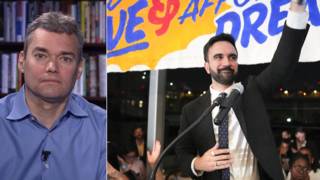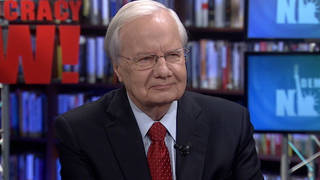
We take a look at Reagan’s policies on race and civil rights with the Rev. Graylan Hagler, discussing the former president’s assault on affirmative actions and social welfare programs and the rise of the crack epidemic in African American communities. [Includes transcript]
Throughout the week on Democracy Now!, we have reported extensively on the Record of Ronald Reagan during his 8 years in office. From Iran-Contra, to the bloody US-fuelled conflicts in Central America, to his administration’s arming of both Iran and Iraq, to his invasion of Grenada and the nuclear arms race. Our series is called “Remembering the Dead.” Later in the program, we will take a close look at Reagan’s policy toward apartheid South Africa.
But first, we are going to shift gears and take a close look at Reagan’s policies at home, here in the US. Among Reagan’s achievements that you won’t hear about from most of the pundits is that Reagan was the first president to turn the US into a debtor nation, nearly tripling the nation’s debt in his 8 years in office. He was also the first president since the Great Depression to see unemployment hit more than 10%. Reagan cracked down on organized labor and America’s homeless population grew to over 2 million people. On the issue of race, the most cited moment of the Reagan presidency during the past week was that he signed legislation for a national holiday honoring Dr. Martin Luther King Jr.. But this is hardly representative of Reagan’s policies on race and civil rights.
Ronald Reagan launched his campaign for the presidency in Philadelphia, Mississippi. That is the place now infamous from the civil rights movement. It was where three civil rights workers were murdered in one of the most well-known cases of racist violence from the 60s. During his first run for office, Reagan proudly waved his Dixiecrat credentials, saying: “I believe in states’ rights and I believe in people doing as much as they can for themselves at the community level and at the private level.”
After taking office in 1981, Reagan began a sustained attack on the government’s civil rights apparatus, opened an assault on affirmative action and social welfare programs, embraced the White racist leaders of then-apartheid South Africa and waged war on the tiny, Black Caribbean nation of Grenada. During his presidency, Reagan fired members of the U.S. Commission on Civil Rights who criticized his civil rights policies, including his strong opposition to affirmative action programs. One of the commissioners recalls that the judge who overturned the dismissal did so because “you can’t fire a watchdog for biting.” Reagan also attempted to limit and gut the Voting Rights Act and he slashed important programs like the Comprehensive Employment and Training Act that provided assistance to many African Americans.
- Rev. Graylan Hagler, president of Ministers for Racial, Social and Economic Justice.
Transcript
AMY GOODMAN: Can you talk today about President Reagan’s record during the 1980s?
REV. GRAYLAN HAGLER: Oh yes, I mean, one of the things that’s very very interesting and alarming to me is that the country and the commercial media particularly seems to be remembering a Ronald Reagan that did not exist for those of us who are Black and other people of color and women because they speak about him, as if he was a saint, when the reality is that everything he represented was the old historical white racist ideology of this nation . I mean the fact that the campaign wasn’t even started in Philadelphia, Mississippi. The reality that this was a attack s upon Affirmative Action and the dismantling really of social programs the closing of hospitals and programs that put people out on the streets that we still live with the homeless population that was started then. I mean all of those types of issues are very alarming and obviously we are seeing a very mythologized image of Reagan currently.
AMY GOODMAN: Can you talk specifically about the Reagan years as they relate to Affirmative Action?
REV. GRAYLAN HAGLER: Well, I mean obviously yes may I think that, one is that we continue to see a really orchestrated attack . The framing of Affirmative Action as somehow reverse discrimination, as they kept using that or, and the reality is, that was not the reality and it continues to stalk as an attack upon Black people upon other people of color, upon women a resistance of that even when we talk about the signing of the legislation for the Martin Luther King holiday, that was not done with open arms by Reagan and his administration; in fact he referred to it as signing it because of all this hoopla that was created and that was by grassroots communities and Black leadership that pushed it, so there was not an open arm policy towards anything that really represented the bulk of us.
AMY GOODMAN: Rev. Hagler as we continue our series “Remembering the Dead”, can you talk about the 1980’s in terms of drugs in this country?
REV. GRAYLAN HAGLER: Oh yeah, one of the things is the communities really got hit with the drug epidemic, really the crack epidemic. There were stories circulating for years, that this was one way the Contras were funded and Central America was basically, through the funneling of drugs, to the black communities but one thing is really sure, the crack epidemic grew and expanded and virtually devastated a generation and subsequent generation and greatly impoverished the communities even more so that is also whether how we look at it that is the manifestation of the Reagan Administration and it is a story of two societies and a story of two worlds. One world, obviously the commercial media is talking about, is a white world that the white world is in charge but the other side of the story, one that is not being talked about is the devastatation that has been heaped upon people of color, poor people, women and their children in the society.
…
AMY GOODMAN: Reverend Hagler, as you listen to this conversation, you’re also based in Washington, where the state funeral is taking place today, of Ronald Reagan. Can you share your final thoughts?
REV. GRAYLAN HAGLER: Well, I mean, one of the things is that — I mean, I just was listening to all of the comments and the comments are extremely important for us to just simply remember that what we are seeing and hearing is not real, but we’re still paying the costs of this administration. We’re still having to deal with what was started, sort of a very anti-labor movement. A backlash to the movements that moved people in a sense from the back of the bus to hopes to have a place in the society. We’re still suffering from the backlash of that economic restructuring that took place under the administration that is simply made the wealthier even that much more wealthy. To a obscene level, and made the working class and the poor poorer and dispossessed us of a place to live, a dignity and respect. You know, just continual attacks that are carried out right now through this day. What we’re also really witnessing is in a sense right now and what happened when Reagan was elected was that the old guard who felt that they had lost power in this country by having to open up their arms and include a very diverse constituency, and at least give that very diverse constituency hope and a sense of possibility. When Reagan was elected, it was a real establishment of that old guard being back in charge. And the message was clear. Not only domestically, but around the world, that it’s time to get back to the back of the bus. There is a new driver in charge, and that driver is the old historical driver that basically maintained a system of rich and poor. A system of black and white.













Media Options